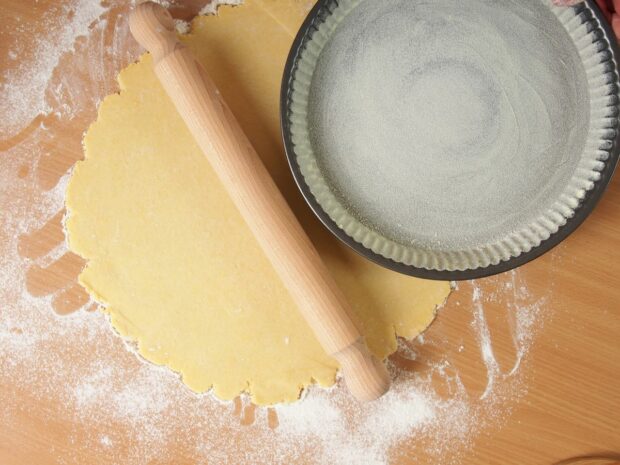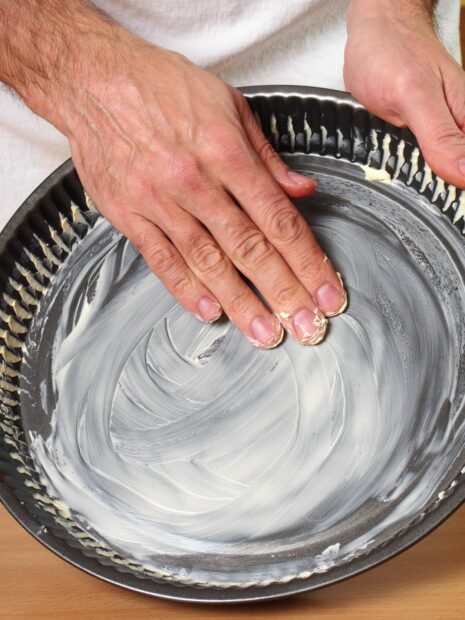Nobody wants to spend hours making a delicious pie only for the pie crust to stick to the pan and cause a mess. Conventional wisdom says that you grease baking trays when making brownies or cakes, but should you grease a pie pan?
Experts say that, in most cases, you should not grease a pie pan. Sticking is not as common with pies due to the crust material and serving style. In fact, greasing your pie pan could cause problems with the pie later on. However, in very specific circumstances, you do need to grease your pie pan.
Here is everything you need to know about preparing your pie dish for baking pies.

Why Is Greasing a Pie Pan Not Recommended?
There are a few reasons why bakers and recipe developers usually don’t tell you to grease a pie pan.
One reason has to do with the ingredients in the pie crust. Pie crust is usually very rich in butter and other fats. This means that the crust is smooth, tender, and flaky. Since the crust already has high fat content, it is not prone to sticking to the pie dish. The fatty crust will grease the base of the pan.
In fact, adding any more grease to your already greasy crust could affect the final texture. More butter will affect the texture of the pie and make it feel greasy even after you bake it.

When Should You Grease a Pie Pan?
While you don’t have to grease a pie dish in most cases, there are a few situations when a light coating of grease might be helpful. Here are the situations in which you might have to grease your baking dish.
The Type of Crust
Most traditional pie recipes use a flaky crust, which is full of butter and will slip out of your pie tin very easily. However, if you are using a short-crust pastry, which is more common for tarts, you should grease your pan at least a little bit. These crusts contain less fat and are more prone to sticking.
Another situation in which you should lightly grease your pie dish is if you are using a chilled crust—graham cracker crust, for example—rather than a baked crust. You usually have to press these crusts into the pie dish tightly, then wait for them to chill, which can result in a crust that is harder to take out later.
The Type of Filling
It makes sense that the type of crust you use will affect how prone the pie is to sticking, but it might surprise you to know that the same applies to your filling. If you have a very sticky filling in your pie, such as fruit or peanut butter, then your pie will be prone to sticking.
The reason why is that pies sometimes leak as they bake, particularly if there is a crack in the crust. The sticky filling will bind your pie crust to the pie dish. If you’re still perfecting your pie crust recipe and sometimes experience leakage or just want to be safe, then lightly greasing your pie plate is fine.

The Material of the Pie Plate
Certain materials are more prone to sticking than others.
If you are baking with a ceramic or glass pie plate, you usually don’t have to grease the pie plate at all. These materials are smooth and do not stick to pie crusts.
However, aluminum pans are more prone to sticking. You shouldn’t run into a massive problem, even with aluminum, due to the high fat content of pie crust. But you can still lightly grease the pan just to make sure.

Your Serving Idea
If you are planning to remove the pie from its pan before serving it, you should grease the pan first.
That’s why you usually need to grease tart dishes, not pie dishes. Tarts are served on a separate plate, so the baking dish needs to be greased very well to prevent issues with sticking (particularly with all the delicate fluting).
If you are hoping to do some fancy creative work when serving your pie instead of simply serving it in the baking dish, then lightly greasing the pan beforehand will make it easier to remove it. This is particularly important if your pie dish has many flutes in which little bits of the dough can get stuck.
How To Properly Grease a Pie Plate To Prevent Stuck Pie Crust
In most situations, you shouldn’t grease your pie plate. But if you have to, be careful not to grease the pie plate too much.
The best method is to use cooking spray. Cooking spray will lightly grease the surface and ensure an even coating without adding too much grease to the crust.
If you don’t have cooking spray on hand, use the wrapper from a stick of butter. This allows you to reach every bit of the pie plate without flooding the tin with extra grease.
Summary
Greasing a pie plate is unnecessary in most situations. However, if you’re using a sticky filling, an aluminum pan, or a pan you won’t be serving the pie in, you can coat it lightly with cooking spray.
